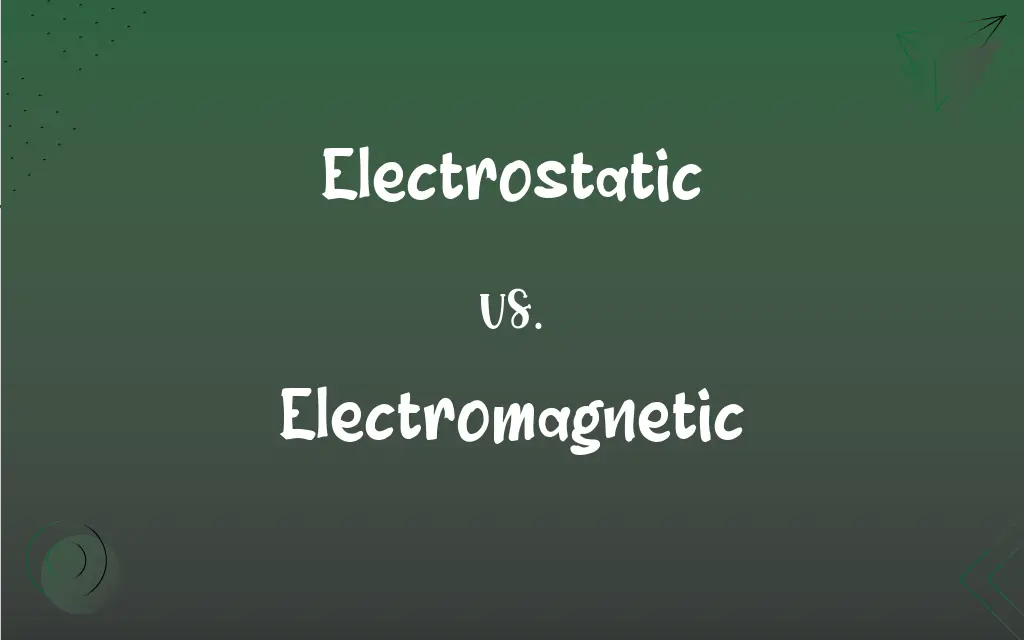Electrostatic vs. Electromagnetic: What's the Difference?
Edited by Aimie Carlson || By Harlon Moss || Published on December 26, 2023
Electrostatics deals with stationary electric charges, while electromagnetism involves electric charges in motion, creating magnetic fields.

Key Differences
Electrostatics focuses on the study and behavior of electric charges at rest. It involves forces, fields, and potentials arising from static electric charges. Electromagnetism, on the other hand, encompasses both electric and magnetic fields, especially when charges are in motion. It deals with the interplay between electric currents and magnetic fields.
The principles of electrostatics are governed by laws like Coulomb's law, which describes the force between static charges. Electromagnetic phenomena are explained by Maxwell's equations, which unify the concepts of electricity and magnetism into a single theory. These equations describe how electric and magnetic fields are generated and altered by each other and by charges and currents.
Electrostatic effects, such as the attraction or repulsion between charged objects, are most noticeable when objects have a significant amount of static charge. Electromagnetic effects, in contrast, include phenomena like the generation of magnetic fields around electric currents and the induction of currents by changing magnetic fields.
In electrostatics, the electric field is described as emanating from static charges, with field lines beginning or ending on these charges. In electromagnetism, electric and magnetic fields are dynamic, with magnetic fields typically depicted as closed loops, not beginning or ending, and electric fields induced by changing magnetic fields.
Applications of electrostatics include electrostatic precipitators and photocopiers. Electromagnetic applications are more diverse, encompassing electric motors, generators, radio waves, and the entire spectrum of electromagnetic radiation, from radio waves to gamma rays.
ADVERTISEMENT
Comparison Chart
Nature of Charges
Involves stationary electric charges.
Deals with moving electric charges.
Fundamental Laws
Governed by Coulomb's law for static charges.
Governed by Maxwell's equations, unifying electricity and magnetism.
Field Characteristics
Electric fields from static charges, no magnetic fields.
Both electric and magnetic fields, dynamic in nature.
Typical Phenomena
Static cling, lightning, and other static charge effects.
Electric motors, radio waves, and electromagnetic induction.
Applications
Electrostatic precipitators, photocopiers.
Wide-ranging, including communication, medicine, and energy.
ADVERTISEMENT
Electrostatic and Electromagnetic Definitions
Electrostatic
Electrostatics involves the study of stationary electric charges.
The electrostatic attraction between clothes in a dryer is due to static electricity.
Electromagnetic
Electromagnetic fields arise from moving electric charges.
An electromagnetic field is generated around a wire carrying an electric current.
Electrostatic
Electrostatic forces arise from the interaction between static electric charges.
Electrostatic force is responsible for the sticking of a balloon to a wall after rubbing it against hair.
Electromagnetic
Electromagnetic radiation includes a wide range of wavelengths, from radio waves to gamma rays.
X-rays, a form of electromagnetic radiation, are used for medical imaging.
Electrostatic
Electrostatic fields are created by charges that are not in motion.
An electrostatic field is created around a charged plastic rod.
Electromagnetic
Electromagnetism encompasses the study of electric and magnetic fields.
Electromagnetic waves are used in transmitting TV and radio signals.
Electrostatic
Electrostatic phenomena occur due to the accumulation of static electricity.
Walking on a carpet can generate electrostatic charges leading to a shock when touching a metal object.
Electromagnetic
Electromagnetic forces are fundamental interactions between electrically charged particles.
Electromagnetic forces are at work in electric motors.
Electrostatic
Electrostatics deals with the laws governing static electric charges and their effects.
Electrostatic discharge is a common issue in electronic device manufacturing.
Electromagnetic
Electromagnetic induction is the process of generating an electric current through a changing magnetic field.
Electromagnetic induction is the principle behind the working of an electric generator.
Electrostatic
Of or relating to electric charges at rest.
Electromagnetic
Of or exhibiting electromagnetism.
Electrostatic
Produced or caused by such charges.
Electromagnetic
Relating to electromagnetism
Electrostatic
Of or relating to electrostatics.
Electromagnetic
Pertaining to or exhibiting magnetism produced by electric charge in motion;
Electromagnetic energy
Electrostatic
(electricity) of, relating to, or produced by electrostatics or static electricity
Electrostatic
Pertaining to electrostatics.
Electrostatic
Concerned with or producing or caused by static electricity;
An electrostatic generator produces high-voltage static electricity
FAQs
How are electromagnetic waves created?
Electromagnetic waves are generated by oscillating electric and magnetic fields.
What is electrostatics?
Electrostatics is the study of stationary electric charges and their effects.
What does electromagnetism cover?
Electromagnetism covers the study of electric and magnetic fields and their interactions.
Can electrostatics generate a magnetic field?
No, electrostatics involves stationary charges which do not create magnetic fields.
Can electrostatic charges be harmful?
Yes, high electrostatic charges can lead to damaging electrostatic discharge.
How does electrostatic painting work?
Electrostatic painting uses charged particles to efficiently coat objects with paint.
How does electromagnetic radiation affect us?
Electromagnetic radiation can be harmful in high doses but is also used beneficially in medicine and communications.
What is the significance of Maxwell's equations?
Maxwell's equations unify the concepts of electricity and magnetism into a coherent framework.
Are electrostatic forces different from electromagnetic forces?
Yes, electrostatic forces relate to static charges, while electromagnetic forces involve moving charges and magnetic fields.
Is lightning an electrostatic or electromagnetic phenomenon?
Lightning is primarily an electrostatic phenomenon due to the discharge of static electricity.
How do microwaves use electromagnetic radiation?
Microwaves use electromagnetic radiation to heat food by agitating water molecules.
What role does electromagnetism play in communication technology?
Electromagnetism is crucial in communication, as it enables the transmission of radio and TV signals.
Is electrostatic force a long-range force?
Yes, electrostatic force can act over long distances, though its strength decreases with distance.
Can electromagnetism be used for energy generation?
Yes, electromagnetic induction is used in generating electrical energy in power plants.
Are X-rays a form of electromagnetic radiation?
Yes, X-rays are a high-energy form of electromagnetic radiation used in imaging.
Are electric motors an example of electromagnetism?
Yes, electric motors operate on electromagnetic principles.
Can electrostatic fields induce currents?
No, only changing electromagnetic fields can induce currents.
What is Coulomb's law?
Coulomb's law describes the force between two stationary electric charges.
What is an example of electrostatic use in everyday life?
Photocopiers use electrostatic principles to transfer toner to paper.
Do all electromagnetic waves move at the same speed?
Yes, in a vacuum, all electromagnetic waves travel at the speed of light.
About Author
Written by
Harlon MossHarlon is a seasoned quality moderator and accomplished content writer for Difference Wiki. An alumnus of the prestigious University of California, he earned his degree in Computer Science. Leveraging his academic background, Harlon brings a meticulous and informed perspective to his work, ensuring content accuracy and excellence.
Edited by
Aimie CarlsonAimie Carlson, holding a master's degree in English literature, is a fervent English language enthusiast. She lends her writing talents to Difference Wiki, a prominent website that specializes in comparisons, offering readers insightful analyses that both captivate and inform.








































































